Polyphasic Systematics of the Fungicolous Genus Cladobotryum Based on Morphological, Molecular and Metabolomics Data
Abstract
1. Introduction
2. Materials and Methods
2.1. Fungal Material and Culture Conditions
2.2. Morphological Study
2.3. Molecular Phylogenetic Analyses
2.3.1. DNA Extraction and PCR Reaction
2.3.2. Phylogenetic Tree Reconstruction
2.4. NMR-Based Metabolomics
2.4.1. Metabolite Extraction
2.4.2. NMR Spectroscopy
2.4.3. Statistical Analysis
3. Results
3.1. Morphological Study
3.2. Molecular Analyses
3.3. NMR-Based Metabolomics/Chemotaxonomy
4. Discussion
4.1. Contribution of Data Derived from Morphology and Notes on Ecology
4.2. Contribution of Data Derived from Molecular Phylogenetic Analyses
4.3. Contribution of Data Derived from NMR-Based Metabolomics
Supplementary Materials
Author Contributions
Funding
Institutional Review Board Statement
Informed Consent Statement
Data Availability Statement
Conflicts of Interest
References
- Samuels, G.J.; Seifert, K.A. Taxonomic Implications of Variation among Hypocrealean Anamorphs. In Pleomorphic Fungi: The Diversity and Its Taxonomic Implications; Sugiyama, J., Ed.; Elsevier: Tokyo, Japan, 1987; pp. 29–56. ISBN 978-0-444-98966-6. [Google Scholar] [CrossRef]
- Põldmaa, K. Generic Delimitation of the Fungicolous Hypocreaceae. Stud. Mycol. 2000, 45, 83–94. [Google Scholar]
- Rossman, A.Y.; Seifert, K.A.; Samuels, G.J.; Minnis, A.M.; Schroers, H.-J.; Lombard, L.; Crous, W.; Põldmaa, K.; Cannon, P.F.; Summerbell, R.C.; et al. Genera in Bionectriaceae, Hypocreaceae, and Nectriaceae (Hypocreales) Proposed for Acceptance or Rejection. IMA Fungus 2013, 4, 41–51. [Google Scholar] [CrossRef] [PubMed]
- Rehner, S.A.; Samuels, G.J. Molecular Systematics of the Hypocreales: A Teleomorph Gene Phylogeny and the Status of Their Anamorphs. Can. J. Bot. 1995, 73, 816–823. [Google Scholar] [CrossRef]
- Sutton, B.C.; Hennebert, G.L. Interconnections amongst Anamorphs and Their Possible Contribution to Ascomycete Systematics. In Ascomycete Systematics; Hawksworth, D.L., Ed.; Springer: Boston, MA, USA, 1994; pp. 77–100. ISBN 978-1-4757-9292-8. [Google Scholar] [CrossRef]
- Rogerson, C.T.; Samuels, G.J. Polyporicolous Species of Hypomyces. Mycologia 1993, 85, 213–272. [Google Scholar] [CrossRef]
- Helfer, W. Pilze Auf Pilzfruchtkörpern: Untersuchungen Zur Ökologie, Systematik Und Chemie; Libri botanici, Band 1; IHW-Verlag: Eching, Germany, 1991. [Google Scholar]
- Gams, W.; Hoozemans, A.C.M. Cladobotryum-Konidienformen von Hypomyces-Arten. Pers.-Mol. Phylogeny Evol. Fungi 1970, 6, 95–110. [Google Scholar]
- Põldmaa, K. The Genus Hypomyces and Allied Fungicolous Fungi in Estonia. I. Species Growing on Aphyllophoralean Basidiomycetes. Folia Cryptogam. Est. 1999, 34, 15–31. [Google Scholar]
- Arnold, G. Über Eine Neue Hypomycetazee, Hypomyces odoratus Arnold Sp. Nov. Čes. Mykol. 1964, 18, 144–146. [Google Scholar]
- Arnold, G.R.W. Über Sibirina Und Sympodiophora Zwei Neue Gattungen Der Moniliales. Nova Hedwig. 1970, 19, 299–304. [Google Scholar]
- Arnold, G.R.W. De Nonnullis Fungis Raris Vel Novis Vel pro URSS Primum Indicatis. Nov. Sist. Nizshikh Rastenii 1971, 8, 130–138. [Google Scholar]
- McNeill, J.; Turland, N.J. Major Changes to the Code of Nomenclature—Melbourne, July 2011. TAXON 2011, 60, 1495–1497. [Google Scholar] [CrossRef]
- Turland, N. The Code Decoded: A User’s Guide to the International Code of Nomenclature for Algae, Fungi, and Plants, 2nd ed.; Pensoft Publishers: Sofia, Bulgaria, 2019; ISBN 978-3-946583-16-5. [Google Scholar] [CrossRef]
- Kirk, P.M.; Stalpers, J.A.; Braun, U.; Crous, P.W.; Hansen, K.; Hawksworth, D.L.; Hyde, K.D.; Lücking, R.; Lumbsch, T.H.; Rossman, A.Y.; et al. A without-prejudice list of generic names of fungi for protection under the International Code of Nomenclature for algae, fungi, and plants. IMA Fungus 2013, 4, 381–443. [Google Scholar] [CrossRef] [PubMed]
- Rudakov, O.L. Physiological Groups in Mycophilic Fungi. Mycologia 1978, 70, 150–159. [Google Scholar] [CrossRef]
- Rossman, A.Y. Morphological and Molecular Perspectives on Systematics of the Hypocreales. Mycologia 1996, 88, 1–19. [Google Scholar] [CrossRef]
- Rossman, A.Y.; Samuels, G.I.; Rogerson, C.T.; Lowen, R. Genera of Bionectriaceae, Hypocreaceae and Nectriaceae (Hypocreales, Ascomycetes). Stud. Mycol. 1999, 42, 1–248. [Google Scholar]
- Hawksworth, D.L. A Survey of the Fungicolous Conidial Fungi. In Biology of Conidial Fungi; Cole, G.T., Kendrick, B., Eds.; Elsevier: New York, NY, USA, 1981; Volume 1, pp. 171–244. [Google Scholar]
- Gams, W.; Diederich, P.; Põldmaa, K. Fungicolous Fungi. In Biodiversity of Fungi; Mueller, G.M., Bills, G.F., Foster, M.S., Eds.; Elsevier: Amsterdam, The Netherlands, 2004; pp. 343–392. ISBN 978-0-12-509551-8. [Google Scholar] [CrossRef]
- Sun, J.-Z.; Liu, X.-Z.; McKenzie, E.H.C.; Jeewon, R.; Liu, J.-K.; Zhang, X.-L.; Zhao, Q.; Hyde, K.D. Fungicolous Fungi: Terminology, Diversity, Distribution, Evolution, and Species Checklist. Fungal Divers. 2019, 95, 337–430. [Google Scholar] [CrossRef]
- Farr, D.F.; Rossman, A.Y. Fungal Databases, U.S. National Fungus Collections, ARS, USDA. Available online: https://nt.ars-grin.gov/fungaldatabases/fungushost/fungushost.cfm (accessed on 2 March 2022).
- Põldmaa, K. Three Species of Hypomyces Growing on Basidiomata of Stereaceae. Mycologia 2003, 95, 921–933. [Google Scholar] [CrossRef]
- Carrasco, J.; Navarro, M.-J.; Gea, F.J. Cobweb, a Serious Pathology in Mushroom Crops: A Review. Span. J. Agric. Res. 2017, 15, e10R01. [Google Scholar] [CrossRef]
- Fletcher, J.T.; Gaze, R.H. Fungal Diseases. In Mushroom Pest and Disease Control: A Colour Handbook; Fletcher, J.T., Gaze, R.H., Eds.; CRC Press: Boca Raton, FL, USA, 2008; pp. 63–91. ISBN 978-1-84076-505-2. [Google Scholar] [CrossRef]
- Gea, F.J.; Navarro, M.J.; Santos, M.; Diánez, F.; Carrasco, J. Control of Fungal Diseases in Mushroom Crops While Dealing with Fungicide Resistance: A Review. Microorganisms 2021, 9, 585. [Google Scholar] [CrossRef]
- Baars, J.; Hendrickx, P.; Sonnenberg, A.; Korsten, L. Global Collection of Mushroom Pathogens; Plant Research International, Part of Wageningen UR Business Unit Plant Breeding: Wageningen, The Netherlands, 2013; p. 41. [Google Scholar]
- Santos, M.; Diánez, F.; Moreno-Gavíra, A.; Sánchez-Montesinos, B.; Gea, F.J. Cladobotryum mycophilum as Potential Biocontrol Agent. Agronomy 2019, 9, 891. [Google Scholar] [CrossRef]
- De Hoog, G.S. Notes Some Fungicolous Hyphomycetes and Their Relatives. Pers.-Mol. Phylogeny Evol. Fungi 1978, 10, 33–81. [Google Scholar]
- Rogerson, C.T.; Samuels, G.J. Agaricicolous Species of Hypomyces. Mycologia 1994, 86, 839–866. [Google Scholar] [CrossRef]
- Põldmaa, K.; Samuels, G.J. Aphyllophoricolous Species of Hypomyces with KOH-Negative Perithecia. Mycologia 1999, 91, 177–199. [Google Scholar] [CrossRef]
- Rogerson, C.T.; Samuels, G.J. Boleticolous Species of Hypomyces. Mycologia 1989, 81, 413–432. [Google Scholar] [CrossRef]
- Valadon, L.R.G.; Chapman, D.J. The Naphthoquinones (Fungal Vacuolation Factor) of Verticillium agaricinum. Microbios Lett. 1983, 24, 115–119. [Google Scholar]
- Nair, M.S.R.; Carey, S.T. Metabolites of Pyrenomycetes: XII. Polyketides from The Hypocreales. Mycologia 1979, 71, 1089–1096. [Google Scholar] [CrossRef] [PubMed]
- Tamm, H.; Põldmaa, K. Diversity, Host Associations, and Phylogeography of Temperate Aurofusarin-Producing Hypomyces/Cladobotryum Including Causal Agents of Cobweb Disease of Cultivated Mushrooms. Fungal Biol. 2013, 117, 348–367. [Google Scholar] [CrossRef]
- Põldmaa, K. Tropical Species of Cladobotryum and Hypomyces Producing Red Pigments. Stud. Mycol. 2011, 68, 1–34. [Google Scholar] [CrossRef]
- Bastos, C.N.; Neill, S.J.; Horgan, R. A Metabolite from Cladobotryum amazonense with Antibiotic Activity. Trans. Br. Mycol. Soc. 1986, 86, 571–578. [Google Scholar] [CrossRef]
- Wagner, C.; Anke, H.; Sterner, O. Rubrobramide, a Cytotoxic and Phytotoxic Metabolite from Cladobotryum rubrobrunnescens. J. Nat. Prod. 1998, 61, 501–502. [Google Scholar] [CrossRef]
- Feng, Y.; Blunt, J.W.; Cole, A.L.J.; Cannon, J.F.; Robinson, W.T.; Munro, M.H.G. Two Novel Cytotoxic Cyclodepsipeptides from a Mycoparasitic Cladobotryum sp. J. Org. Chem. 2003, 68, 2002–2005. [Google Scholar] [CrossRef]
- Mitova, M.I.; Lang, G.; Blunt, J.W.; Cummings, N.J.; Cole, A.L.J.; Robinson, W.T.; Munro, M.H.G. Cladobotric Acids A−F: New Cytotoxic Polyketides from a New Zealand Cladobotryum sp. J. Org. Chem. 2006, 71, 492–497. [Google Scholar] [CrossRef] [PubMed]
- Sakamoto, K.; Tsujii, E.; Abe, F.; Yamashitat, M.; Shigematsu, N.; IzuMift, S.; Okuhara, M. FR901483, a Novel Immunosuppressant Isolated from Cladobotryum sp. No. 11231. Taxonomy of the Producing Organism, fermentation, Isolation, Physico-chemical Properties and Biological Activities. J. Antibiot. 1996, 49, 8. [Google Scholar] [CrossRef] [PubMed]
- Dao, T.-T.; Williams, K.; de Mattos-Shipley, K.M.J.; Song, Z.; Takebayashi, Y.; Simpson, T.J.; Spencer, J.; Bailey, A.M.; Willis, C.L. Cladobotric Acids: Metabolites from Cultures of Cladobotryum sp., Semisynthetic Analogues and Antibacterial Activity. J. Nat. Prod. 2022, 85, 572–580. [Google Scholar] [CrossRef]
- Watanabe, Y.; Yoshida, Y.; Tokiwa, T.; Higo, M.; Ban, S.; Ikeda, A.; Noguchi, Y.; Hirose, T.; Sunazuka, T.; Nonaka, K.; et al. Hakuhybotric Acid, a New Antifungal Polyketide Produced by a Mycoparasitic Fungus Hypomyces pseudocorticiicola FKI-9008. J. Gen. Appl. Microbiol. 2022. [Google Scholar] [CrossRef] [PubMed]
- Breinholt, J.; Jensen, G.W.; Kjær, A.; Olsen, C.E.; Rosendahl, C.N.; Romerosa, A.; Robinson, W.T.; Roos, B.O.; Vallance, C.; Wood, B.R. Hypomycetin—an Antifungal, Tetracyclic Metabolite from Hypomyces aurantius: Production, Structure and Biosynthesis. Acta Chem. Scand. 1997, 51, 855–860. [Google Scholar] [CrossRef]
- McKay, G.J.; Egan, D.; Morris, E.; Scott, C.; Brown, A.E. Genetic and Morphological Characterization of Cladobotryum Species Causing Cobweb Disease of Mushrooms. Appl. Environ. Microbiol. 1999, 65, 606–610. [Google Scholar] [CrossRef]
- Põldmaa, K.; Larsson, E.; Kõljalg, U. Phylogenetic Relationships in Hypomyces and Allied Genera, with Emphasis on Species Growing on Wood-Decaying Homobasidiomycetes. Can. J. Bot. 1999, 77, 13. [Google Scholar] [CrossRef]
- Frisvad, J.C. Fungal Chemotaxonomy. In Biosynthesis and Molecular Genetics of Fungal Secondary Metabolites, Volume 2; Zeilinger, S., Martín, J.-F., García-Estrada, C., Eds.; Fungal Biology; Springer: New York, NY, USA, 2015; pp. 103–121. ISBN 978-1-4939-2530-8. [Google Scholar]
- Frisvad, J.C. Chemical Fungal Taxonomy, 1st ed.; Frisvad, J.C., Bridge, P.D., Arora, D.K., Eds.; CRC Press: Boca Raton, FL, USA, 1998; ISBN 978-1-00-306462-6. [Google Scholar] [CrossRef]
- Frisvad, J.C.; Andersen, B.; Thrane, U. The Use of Secondary Metabolite Profiling in Chemotaxonomy of Filamentous Fungi. Mycol. Res. 2008, 112, 231–240. [Google Scholar] [CrossRef]
- Ząbek, A.; Klimek-Ochab, M.; Jawień, E.; Młynarz, P. Biodiversity in Targeted Metabolomics Analysis of Filamentous Fungal Pathogens by 1H NMR-Based Studies. World J. Microbiol. Biotechnol. 2017, 33, 132. [Google Scholar] [CrossRef]
- Kim, W.; Peever, T.L.; Park, J.-J.; Park, C.-M.; Gang, D.R.; Xian, M.; Davidson, J.A.; Infantino, A.; Kaiser, W.J.; Chen, W. Use of Metabolomics for the Chemotaxonomy of Legume-Associated Ascochyta and Allied Genera. Sci. Rep. 2016, 6, 20192. [Google Scholar] [CrossRef]
- Becker, K.; Wongkanoun, S.; Wessel, A.-C.; Bills, G.F.; Stadler, M.; Luangsa-ard, J.J. Phylogenetic and Chemotaxonomic Studies Confirm the Affinities of Stromatoneurospora phoenix to the Coprophilous Xylariaceae. J. Fungi 2020, 6, 144. [Google Scholar] [CrossRef] [PubMed]
- Maciá-Vicente, J.G.; Shi, Y.-N.; Cheikh-Ali, Z.; Grün, P.; Glynou, K.; Kia, S.H.; Piepenbring, M.; Bode, H.B. Metabolomics-Based Chemotaxonomy of Root Endophytic Fungi for Natural Products Discovery: Chemotaxonomy of Root Endophytic Fungi. Environ. Microbiol. 2018, 20, 1253–1270. [Google Scholar] [CrossRef] [PubMed]
- Kelman, M.J.; Renaud, J.B.; Seifert, K.A.; Mack, J.; Yeung, K.K.-C.; Sumarah, M.W. Chemotaxonomic Profiling of Canadian Alternaria Populations Using High-Resolution Mass Spectrometry. Metabolites 2020, 10, 238. [Google Scholar] [CrossRef] [PubMed]
- Xu, H.; Zhou, L.; Wang, M.; Wei, L.; Qu, H.; Ma, J.; Ju, J.; Han, Z. Chemical Constituents from Marine Derived Fungus Talaromyces cellulolyticus SHJ-3 and Its Chemotaxonomic Significance. Biochem. Syst. Ecol. 2022, 100, 104377. [Google Scholar] [CrossRef]
- Larsen, T.O.; Smedsgaard, J.; Nielsen, K.F.; Hansen, M.E.; Frisvad, J.C. Phenotypic Taxonomy and Metabolite Profiling in Microbial Drug Discovery. Nat. Prod. Rep. 2005, 22, 672. [Google Scholar] [CrossRef] [PubMed]
- Baker, P.M.; Roberts, J.C. Studies in Mycological Chemistry. Part XXI. The Structure of Aurofusarin, a Metabolite of Some Fusarium Species. J. Chem. Soc. C 1966, 2234–2237. [Google Scholar] [CrossRef]
- Shibata, S.; Morishita, E.; Takeda, T.; Sakata, K. The Structure of Aurofusarin. Tetrahedron Lett. 1966, 7, 4855–4860. [Google Scholar] [CrossRef]
- Birchall, G.R.; Bowden, K.; Weiss, U.; Whalley, W.B. The Chemistry of Fungi. Part LVI. Aurofusarin. J. Chem. Soc. C 1966, 2237–2239. [Google Scholar] [CrossRef]
- Gray, J.S.; Martin, G.C.J.; Rigby, W. Aurofusarin. J. Chem. Soc. C 1967, 2578–2580. [Google Scholar] [CrossRef]
- Gea, F.J.; Navarro, M.J.; Suz, L.M. First Report of Cladobotryum mycophilum Causing Cobweb on Cultivated King Oyster Mushroom in Spain. Plant Dis. 2011, 95, 1030. [Google Scholar] [CrossRef]
- Gea, F.J.; Navarro, M.J.; Carrasco, J.; González, A.J.; Suz, L.M. First Report of Cobweb on White Button Mushroom (Agaricus bisporus) in Spain Caused by Cladobotryum mycophilum. Plant Dis. 2012, 96, 1067. [Google Scholar] [CrossRef] [PubMed]
- Gea, F.J.; Carrasco, J.; Suz, L.M.; Navarro, M.J. Characterization and Pathogenicity of Cladobotryum mycophilum in Spanish Pleurotus Eryngii Mushroom Crops and Its Sensitivity to Fungicides. Eur. J. Plant Pathol. 2017, 147, 129–139. [Google Scholar] [CrossRef]
- Gea, F.J.; Navarro, M.J.; Suz, L.M. First Report of Cobweb Disease Caused by Cladobotryum dendroides on Shiitake Mushroom (Lentinula edodes) in Spain. Plant Dis. 2018, 102, 1030. [Google Scholar] [CrossRef]
- Potočnik, I.; Rekanović, E.; Milijasević, S.; Todorović, B.; Stepanović, M. Morphological and Pathogenic Characteristics of the Fungus Cladobotryum dendroides, the Causal Agent of Cobweb Disease of the Cultivated Mushroom Agaricus Bisporus in Serbia. Pestic. Fitomed. 2008, 23, 175–181. [Google Scholar] [CrossRef]
- Milic, N.; Kostidis, S.; Stavrou, A.; Gonou-Zagou, Z.; Kouvelis, V.; Mikros, E.; Fokialakis, N. A Polyphasic Approach (Metabolomics, Morphological and Molecular Analyses) in the Systematics of Cladobotryum Species in Greece. Planta Med. 2012, 78, PG14. [Google Scholar] [CrossRef]
- Riddell, R.W. Permanent Stained Mycological Preparations Obtained by Slide Culture. Mycologia 1950, 42, 265–270. [Google Scholar] [CrossRef]
- Mauri, M.; Elli, T.; Caviglia, G.; Uboldi, G.; Azzi, M. RAWGraphs: A Visualisation Platform to Create Open Outputs. In Proceedings of the 12th Biannual Conference on Italian SIGCHI Chapter, Cagliari, Italy, 18–20 September 2017; ACM: New York, NY, USA, 2017; pp. 1–5. [Google Scholar]
- Inkscape Project; 2021. Available online: https://inkscape.org (accessed on 28 July 2022).
- Kouvelis, V.N.; Ghikas, D.V.; Typas, M.A. The Analysis of the Complete Mitochondrial Genome of Lecanicillium muscarium (Synonym Verticillium lecanii) Suggests a Minimum Common Gene Organization in MtDNAs of Sordariomycetes: Phylogenetic Implications. Funga Genet. Biol. 2004, 41, 930–940. [Google Scholar] [CrossRef]
- Kouvelis, V.N.; Sialakouma, A.; Typas, M.A. Mitochondrial Gene Sequences Alone or Combined with ITS Region Sequences Provide Firm Molecular Criteria for the Classification of Lecanicillium Species. Mycol. Res. 2008, 112, 829–844. [Google Scholar] [CrossRef]
- Burland, T.G. DNASTAR’s Lasergene Sequence Analysis Software. In Bioinformatics Methods and Protocols; Misener, S., Krawetz, S.A., Eds.; Humana Press: Totowa, NJ, USA, 2000; Volume 132, pp. 71–91. ISBN 978-1-59259-192-3. [Google Scholar] [CrossRef]
- Kuraku, S.; Zmasek, C.M.; Nishimura, O.; Katoh, K. ALeaves Facilitates On-Demand Exploration of Metazoan Gene Family Trees on MAFFT Sequence Alignment Server with Enhanced Interactivity. Nucleic Acids Res. 2013, 41, W22–W28. [Google Scholar] [CrossRef]
- Katoh, K.; Rozewicki, J.; Yamada, K.D. MAFFT Online Service: Multiple Sequence Alignment, Interactive Sequence Choice and Visualization. Brief. Bioinform. 2019, 20, 1160–1166. [Google Scholar] [CrossRef]
- Wilgenbusch, J.C.; Swofford, D. Inferring Evolutionary Trees with PAUP. Curr. Protoc. Bioinform. 2003, 6.4.1–6.4.28. [Google Scholar] [CrossRef] [PubMed]
- Ronquist, F.; Huelsenbeck, J.P. MrBayes 3: Bayesian Phylogenetic Inference under Mixed Models. Bioinformatics 2003, 19, 1572–1574. [Google Scholar] [CrossRef]
- Guindon, S.; Gascuel, O. A Simple, Fast, and Accurate Algorithm to Estimate Large Phylogenies by Maximum Likelihood. Syst. Biol. 2003, 52, 696–704. [Google Scholar] [CrossRef] [PubMed]
- Darriba, D.; Taboada, G.L.; Doallo, R.; Posada, D. JModelTest 2: More Models, New Heuristics and Parallel Computing. Nat. Methods 2012, 9, 772. [Google Scholar] [CrossRef] [PubMed]
- Teng, Q.; Huang, W.; Collette, T.W.; Ekman, D.R.; Tan, C. A Direct Cell Quenching Method for Cell-Culture Based Metabolomics. Metabolomics 2009, 5, 199–208. [Google Scholar] [CrossRef]
- Duportet, X.; Aggio, R.B.M.; Carneiro, S.; Villas-Bôas, S.G. The Biological Interpretation of Metabolomic Data Can Be Misled by the Extraction Method Used. Metabolomics 2012, 8, 410–421. [Google Scholar] [CrossRef]
- Matsushima, T. Icones Microfungorum a Matsushima Lectorum; Matsushima: Kobe, Japan, 1975. [Google Scholar]
- Arnold, G.R.W.; Yurchenko, E.O. The First Contribution on Mycophilous Fungi from Belarus. Mycena 2007, 7, 4–19. [Google Scholar]
- Cole, G.T.; Kendrick, B. Conidium Ontogeny in Hyphomycetes. Development and Morphology of Cladobotryum. Can. J. Bot. 1971, 49, 595–599. [Google Scholar] [CrossRef]
- Nair, M.S.R.; Carey, S.T. Metabolites of Pyrenomycetes. XII. Structure of siribinone, a new α-pyrone from Hypomyces. Phytochemistry 1977, 16, 1613. [Google Scholar] [CrossRef]
- Helfer, W. Morphologische, Chemische Und Okologische Characterisierung Mykophiler Pilze. Diploma Thesis, Universitat Regensburg, Regensburg, Germany, 1986. [Google Scholar]
- Nair, M.S.R.; Carey, S.T. Metabolites of Pyrenomycetes IV: Rosellisin, an Antibiotic α-Pyrone from Hypomyces rosellus. Tetrahedron Lett. 1975, 16, 3517–3518. [Google Scholar] [CrossRef]
- Nair, M.S.R. Biogenesis and revised structure of rosellisin. Structure of rosellisin aldhyde. Phytochemistry 1976, 15, 1090–1091. [Google Scholar] [CrossRef]
- Osman, M.; Valadon, L.R.G. Fungistatic Naphthoquinones of Verticillium agaricinum. Trans. Br. Mycol. Soc. 1984, 82, 713–714. [Google Scholar] [CrossRef]
- Huot, R.; Brassard, P. Skyrin from Hypomyces lactifluorum. Phytochemistry 1972, 11, 2879. [Google Scholar] [CrossRef]
- Tezuka, Y.; Huang, Q.; Kikuchi, T.; Nishi, A.; Tubaki, K. Studies on the Metabolites of Mycoparasitic Fungi. I. Metabolites of Cladobotryum varium. Chem. Pharm. Bull. 1994, 42, 2612–2617. [Google Scholar] [CrossRef][Green Version]
- Tulasne, L.R.; Tulasne, C. Selecta Fungorum Carpologia, Ea Documenta et Icones Potissimum Exhibens; Imperatoris Jussu, In Imperiali Typographeo Excudebatur: Paris, France, 1863; Volume 2, p. 101. [Google Scholar] [CrossRef][Green Version]
- Roca, M.G.; Davide, L.C.; Mendes-Costa, M.C.; Wheals, A. Conidial Anastomosis Tubes in Colletotrichum. Fungal Genet. Biol. 2003, 40, 138–145. [Google Scholar] [CrossRef]
- Roca, M.G.; Arlt, J.; Jeffree, C.E.; Read, N.D. Cell Biology of Conidial Anastomosis Tubes in Neurospora crassa. Eukaryot. Cell 2005, 4, 911–919. [Google Scholar] [CrossRef]
- Roca, M.G.; Read, N.D.; Wheals, A.E. Conidial Anastomosis Tubes in Filamentous Fungi. FEMS Microbiol. Lett. 2005, 249, 191–198. [Google Scholar] [CrossRef]
- Shulaev, V. Metabolomics Technology and Bioinformatics. Brief. Bioinform. 2006, 7, 128–139. [Google Scholar] [CrossRef]
- Alhadrami, H.A.; Sayed, A.M.; El-Gendy, A.O.; Shamikh, Y.I.; Gaber, Y.; Bakeer, W.; Sheirf, N.H.; Attia, E.Z.; Shaban, G.M.; Khalifa, B.A.; et al. A Metabolomic Approach to Target Antimalarial Metabolites in the Artemisia annua Fungal Endophytes. Sci. Rep. 2021, 11, 2770. [Google Scholar] [CrossRef]
- Baert, F.; Lefevere, P.; D’hooge, E.; Stubbe, D.; Packeu, A. A Polyphasic Approach to Classification and Identification of Species within the Trichophyton benhamiae Complex. J. Fungi 2021, 7, 602. [Google Scholar] [CrossRef]
- Bills, G.F.; Gloer, J.B. Biologically Active Secondary Metabolites from the Fungi. Microbiol. Spectr. 2016, 4, 1–32. [Google Scholar] [CrossRef]
- Moore, D.; Robson, G.D.; Trinci, A.P.J. 21st Century Guidebook to Fungi, 2nd ed.; Cambridge University Press: Cambridge, UK, 2020; ISBN 978-1-108-77638-7. [Google Scholar]
- Keller, N.P. Fungal Secondary Metabolism: Regulation, Function and Drug Discovery. Nat. Rev. Microbiol. 2019, 17, 167–180. [Google Scholar] [CrossRef]
- Pennycook, S.R. The Correct Authorship of the Genus Hypomyces and Its Original Species. Mycotaxon 2009, 108, 185–195. [Google Scholar] [CrossRef]
- Gray, D.J.; Morgan-Jones, G. Notes on Hyphomycetes. XXXIV. Some Mycoparasitic Species. Mycotaxon 1980, 10, 375–404. [Google Scholar]
- Lenti, I. Mikoparazita Gombák A Bátorligeti Természetvédelmi Területeken. Mikológiai Közlemények Clusiana 2008, 47, 21–30. [Google Scholar]
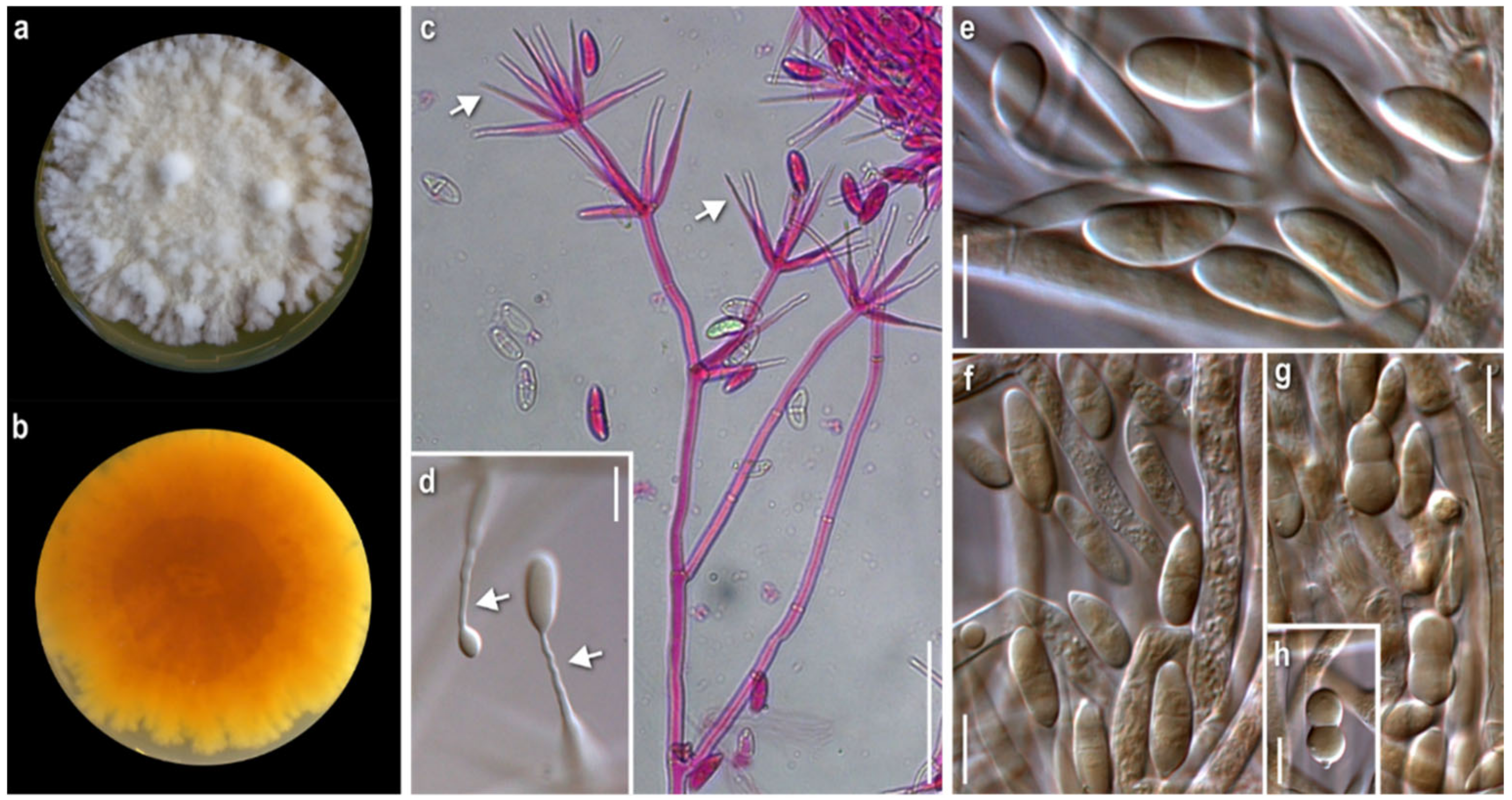


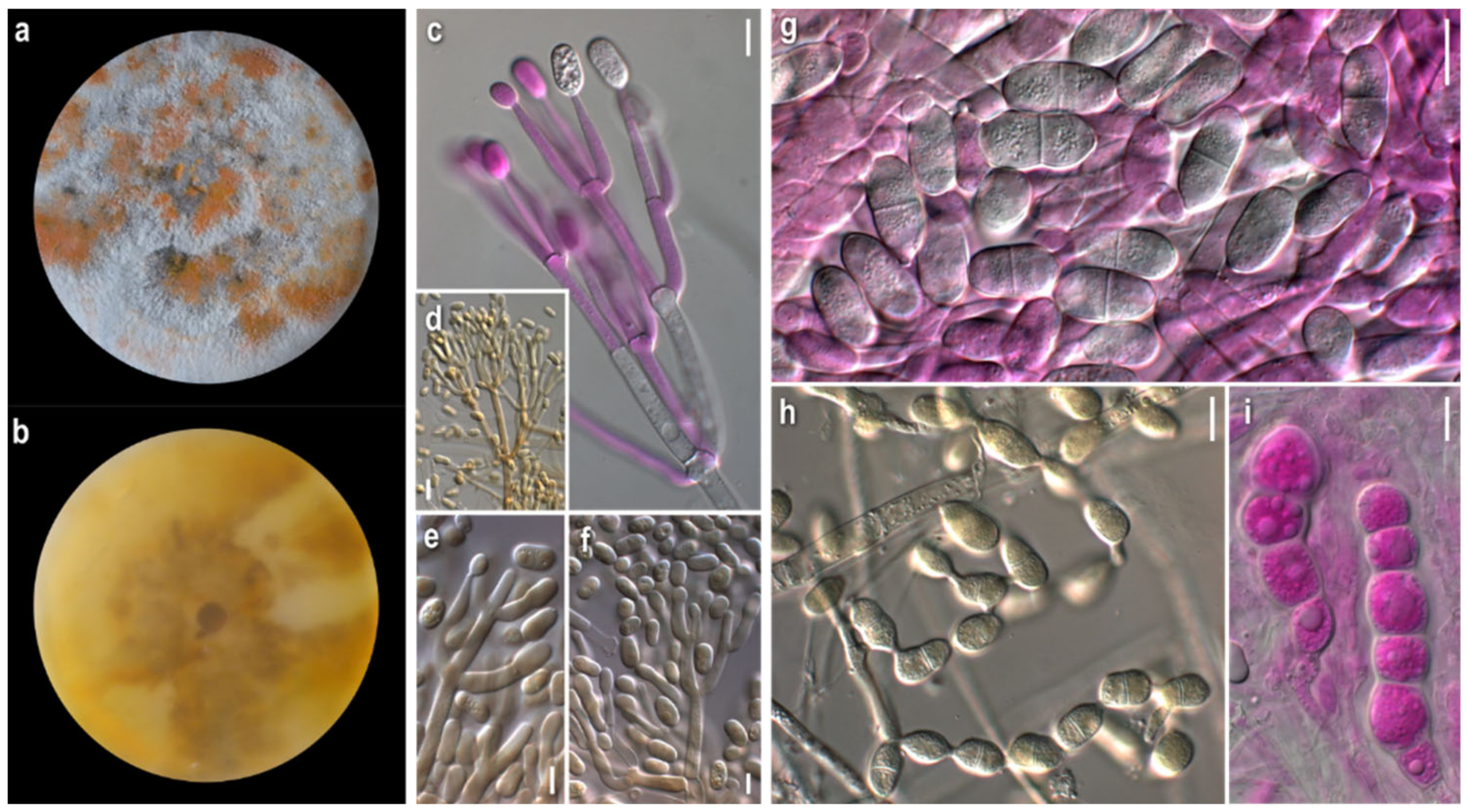
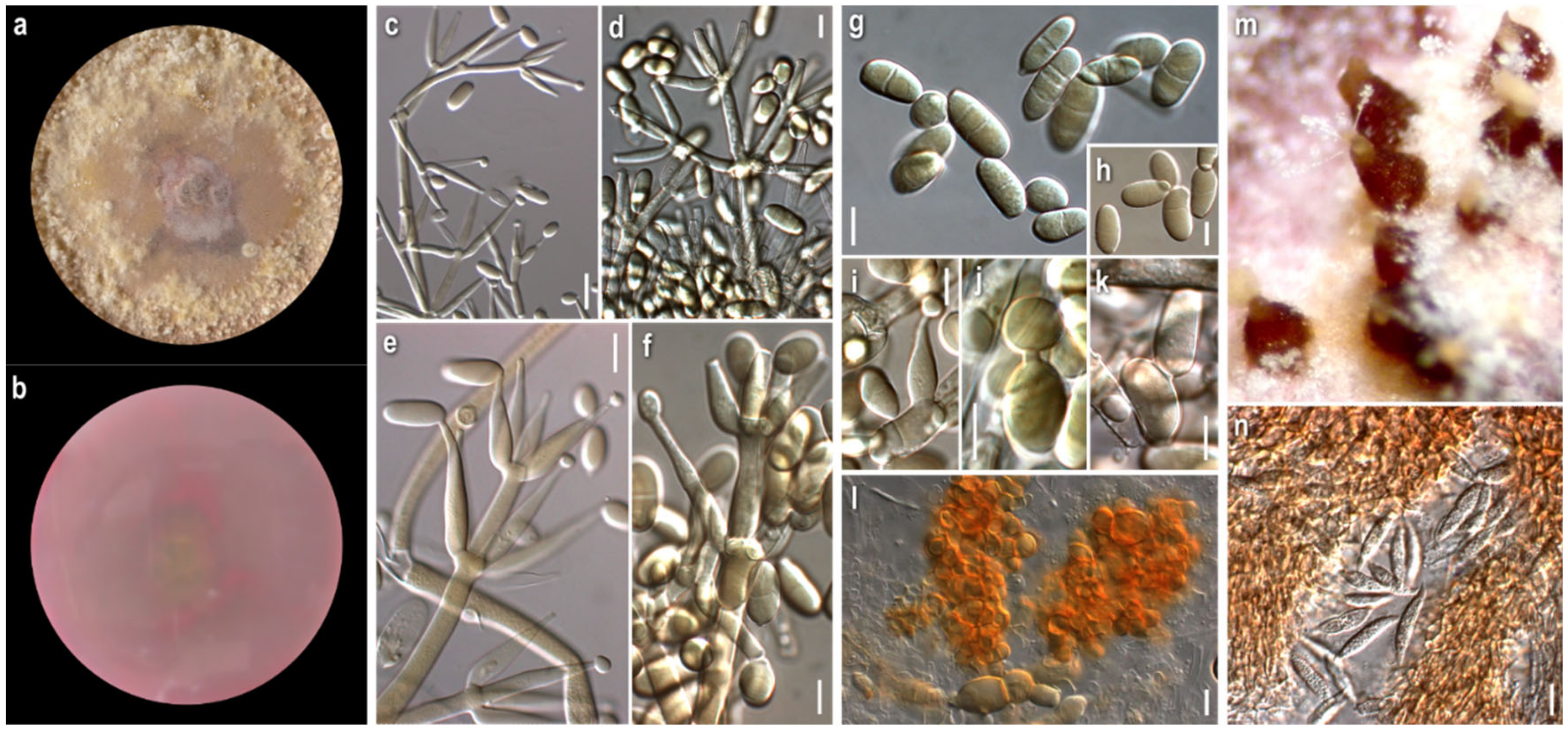
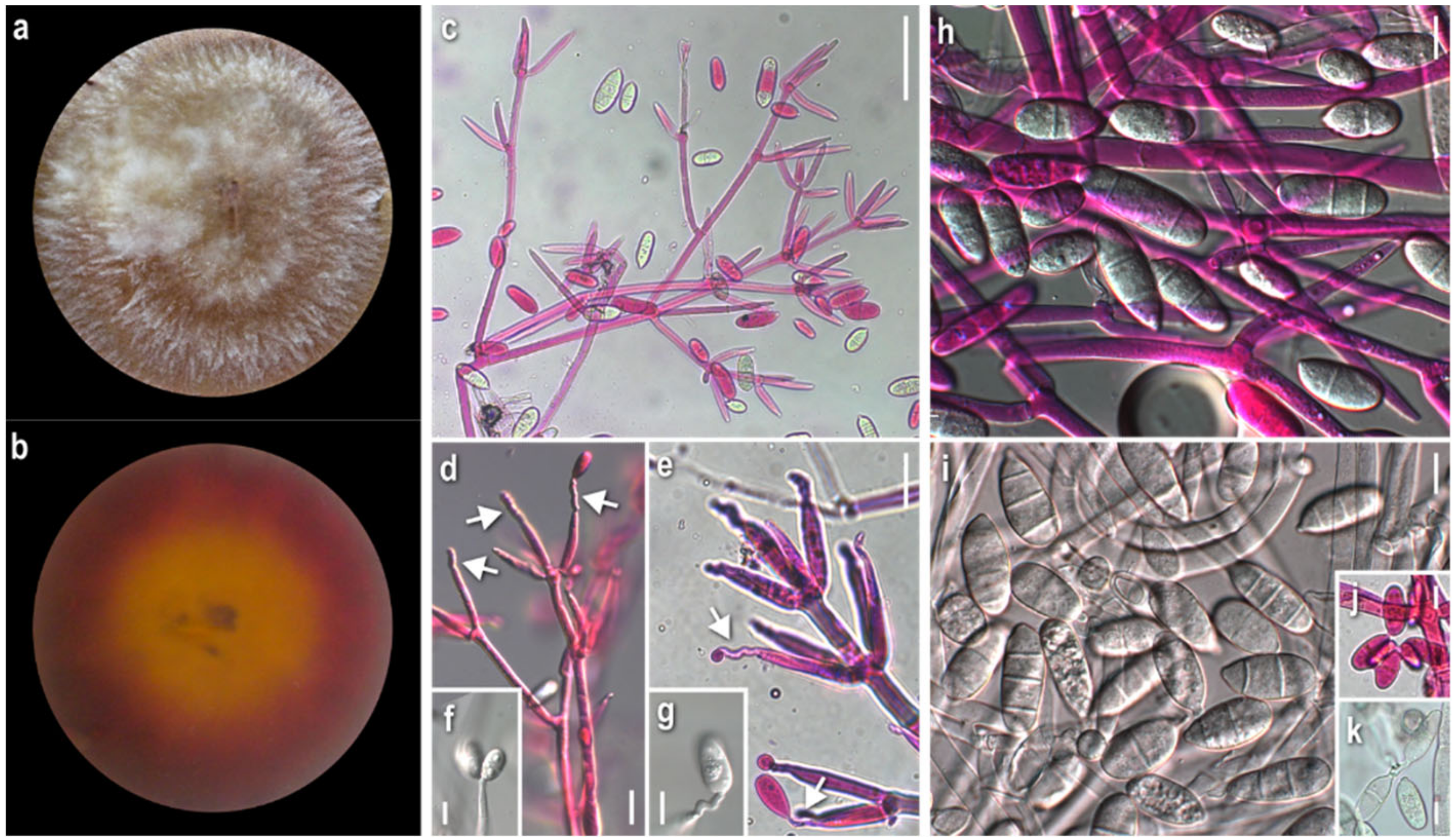
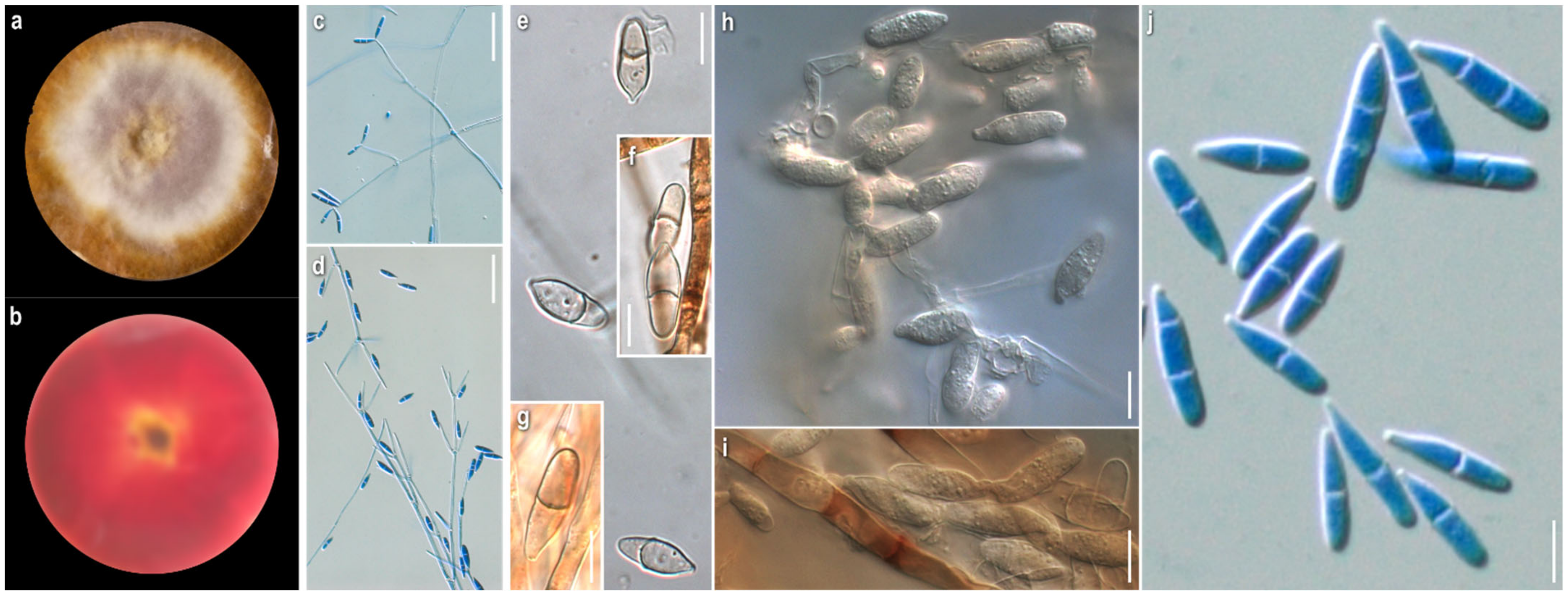
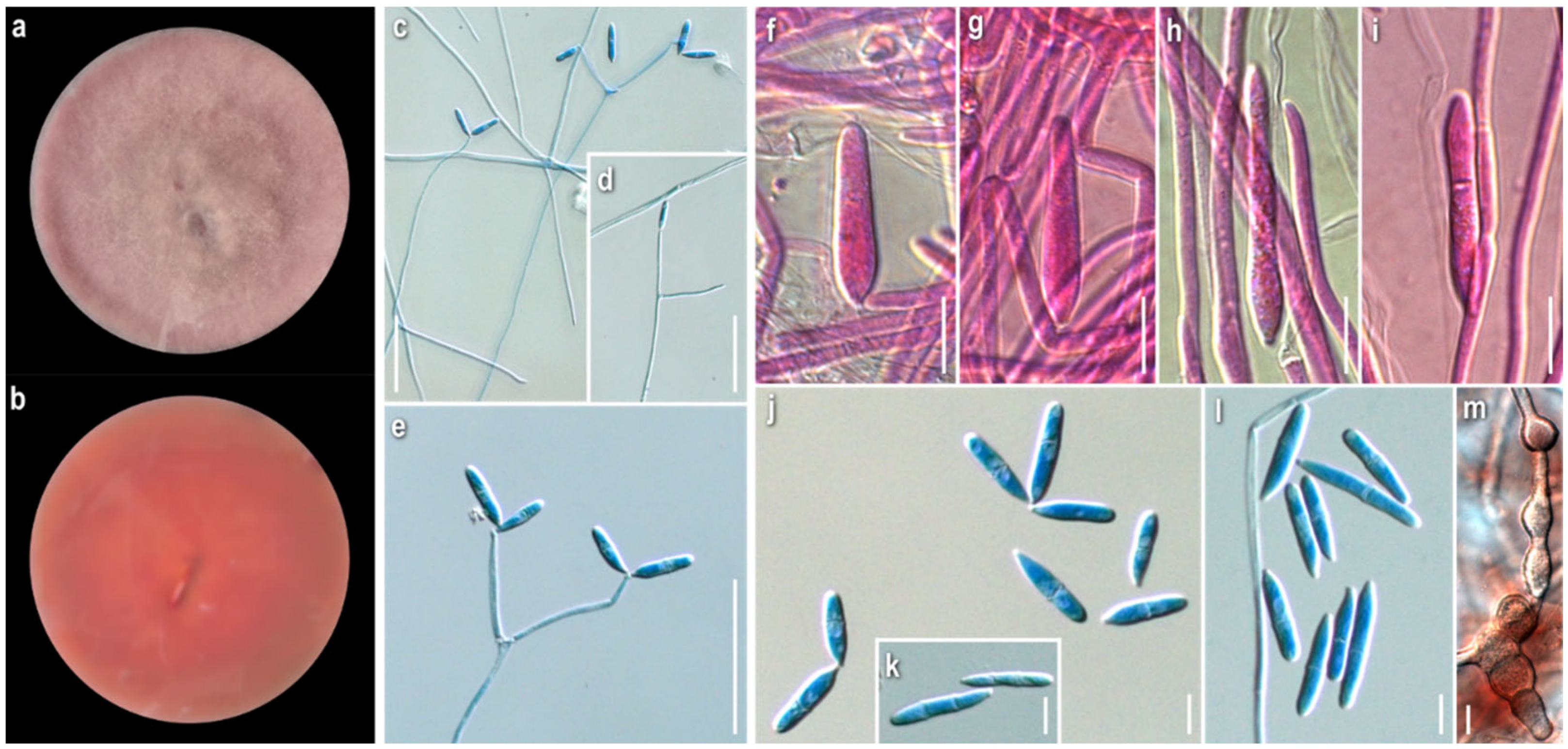

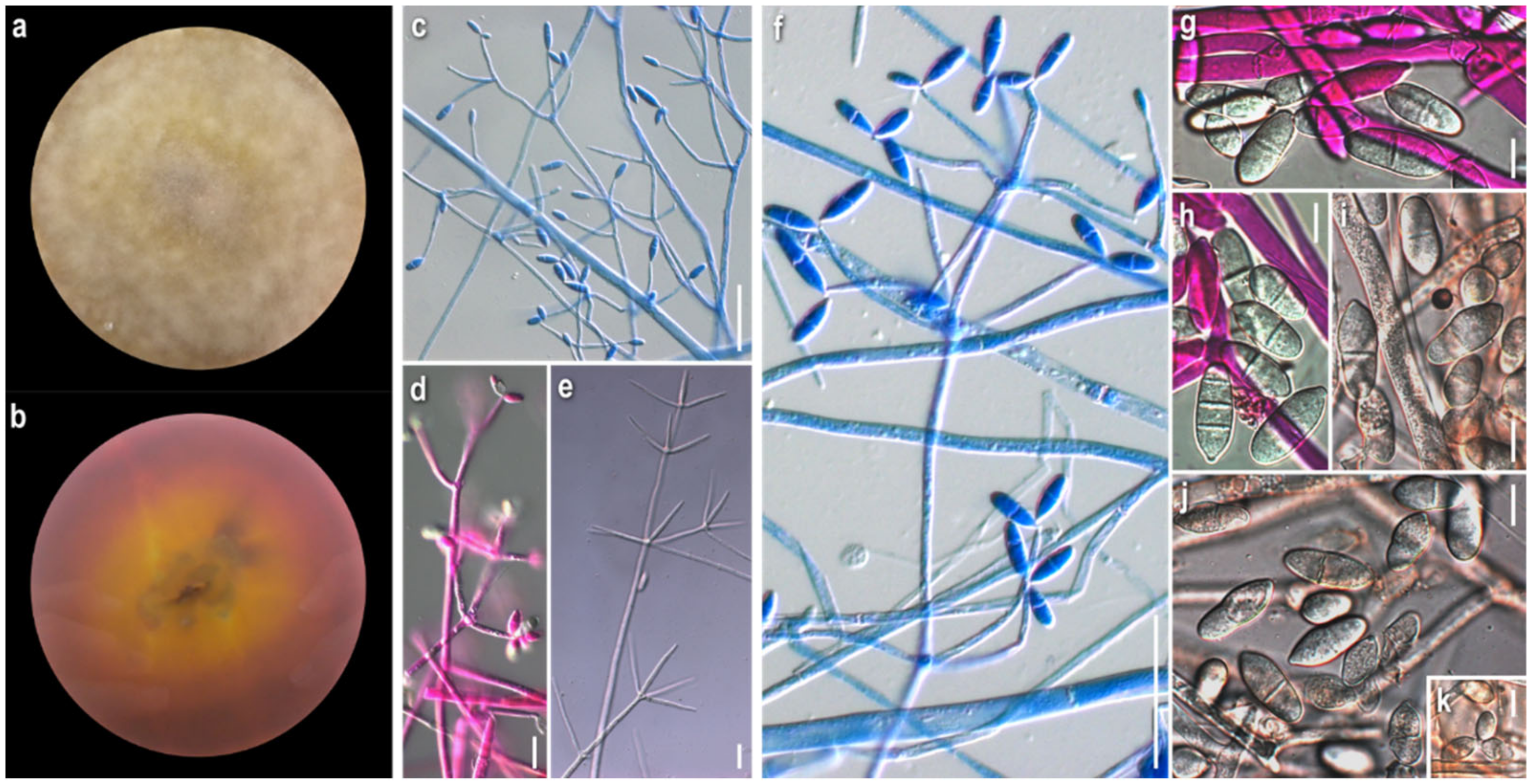
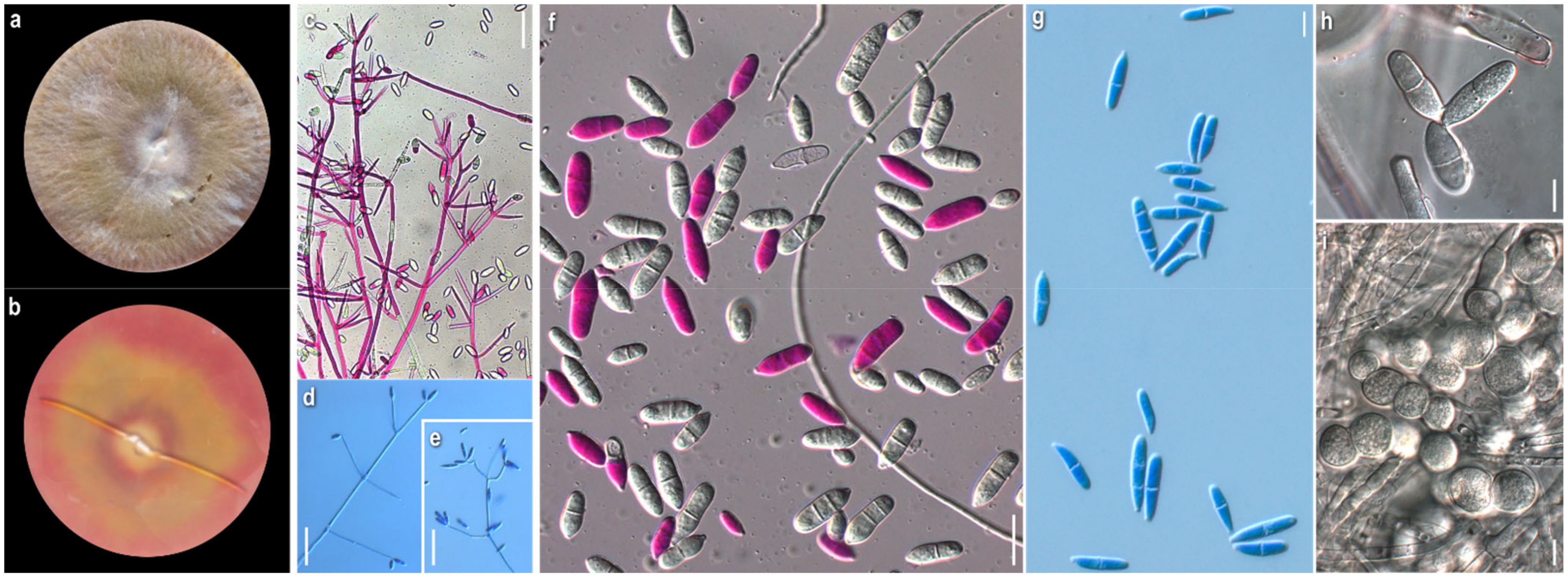
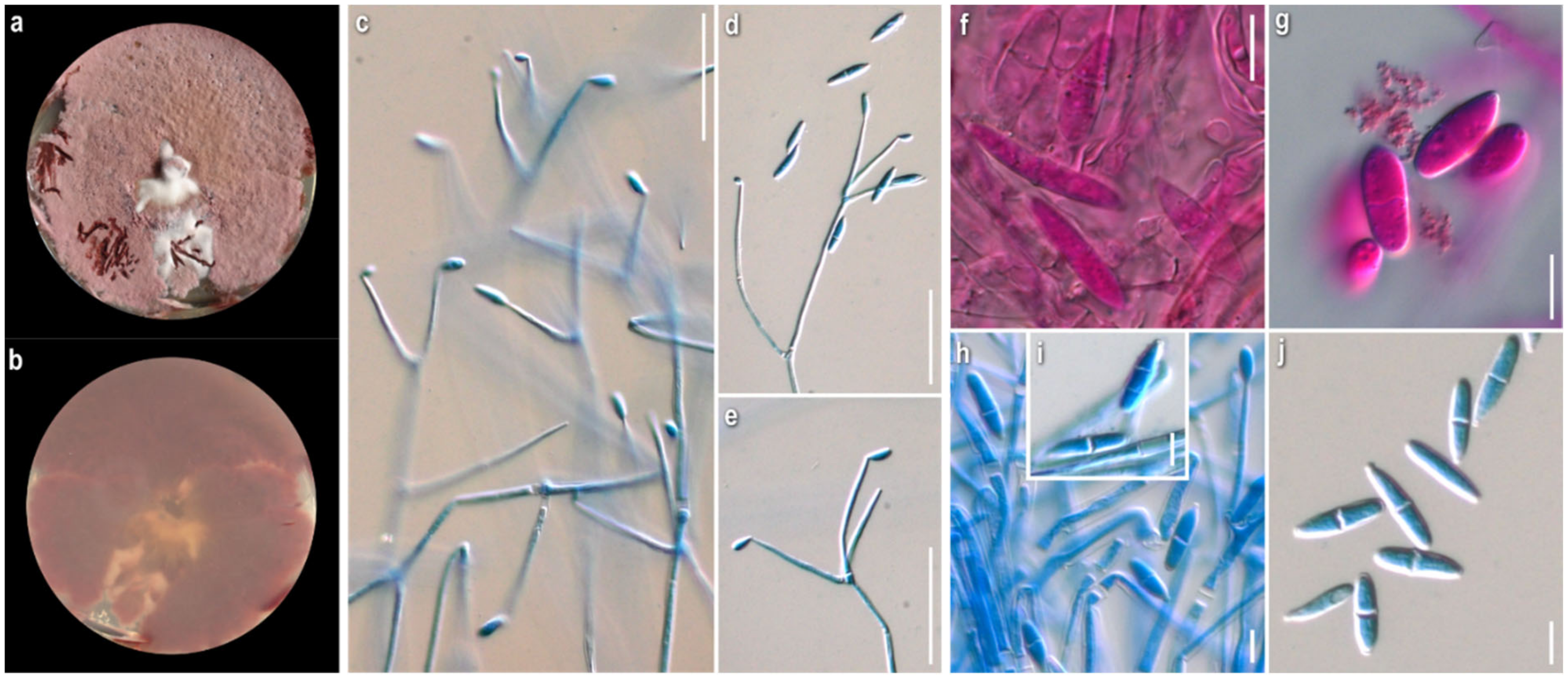
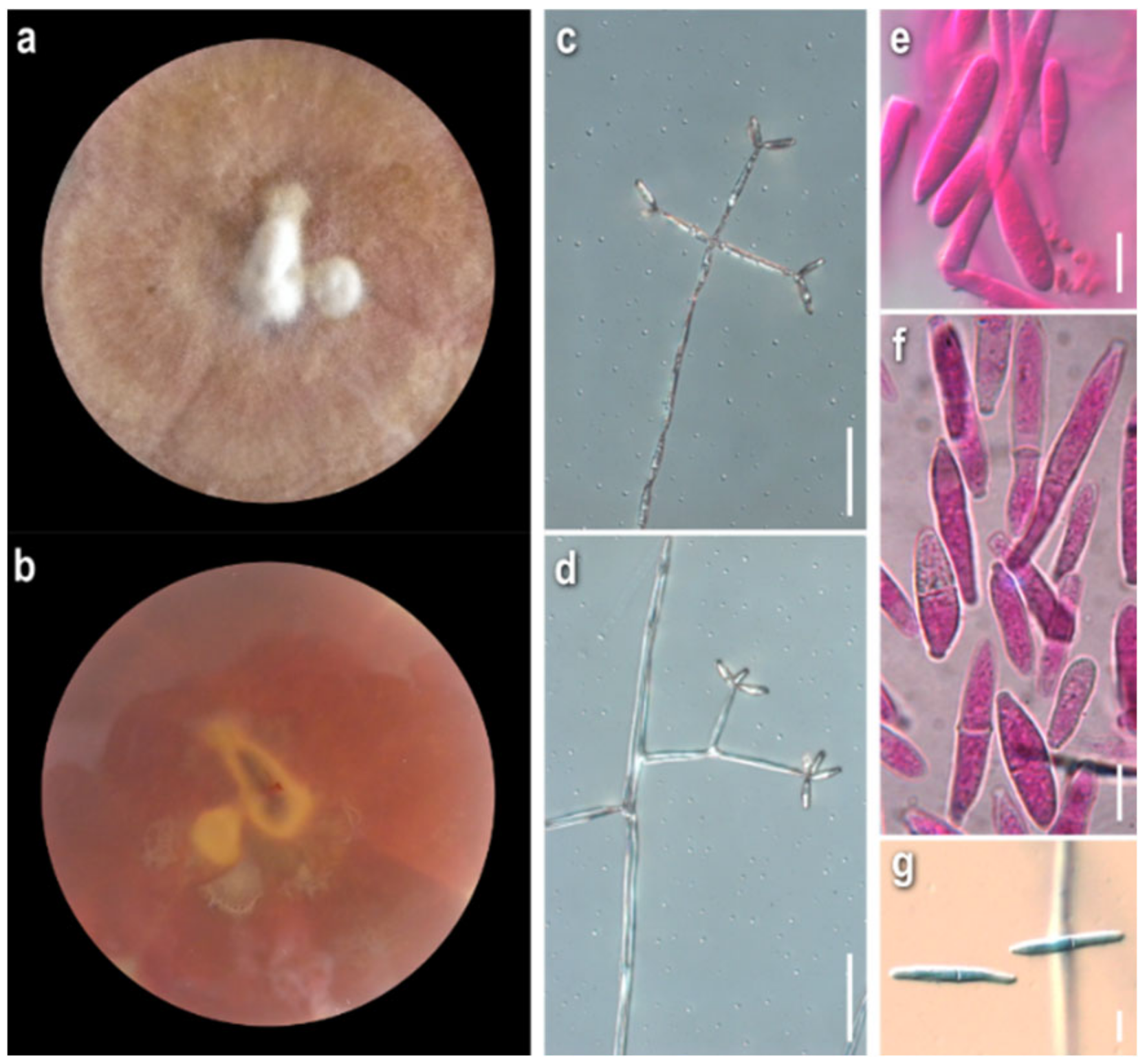

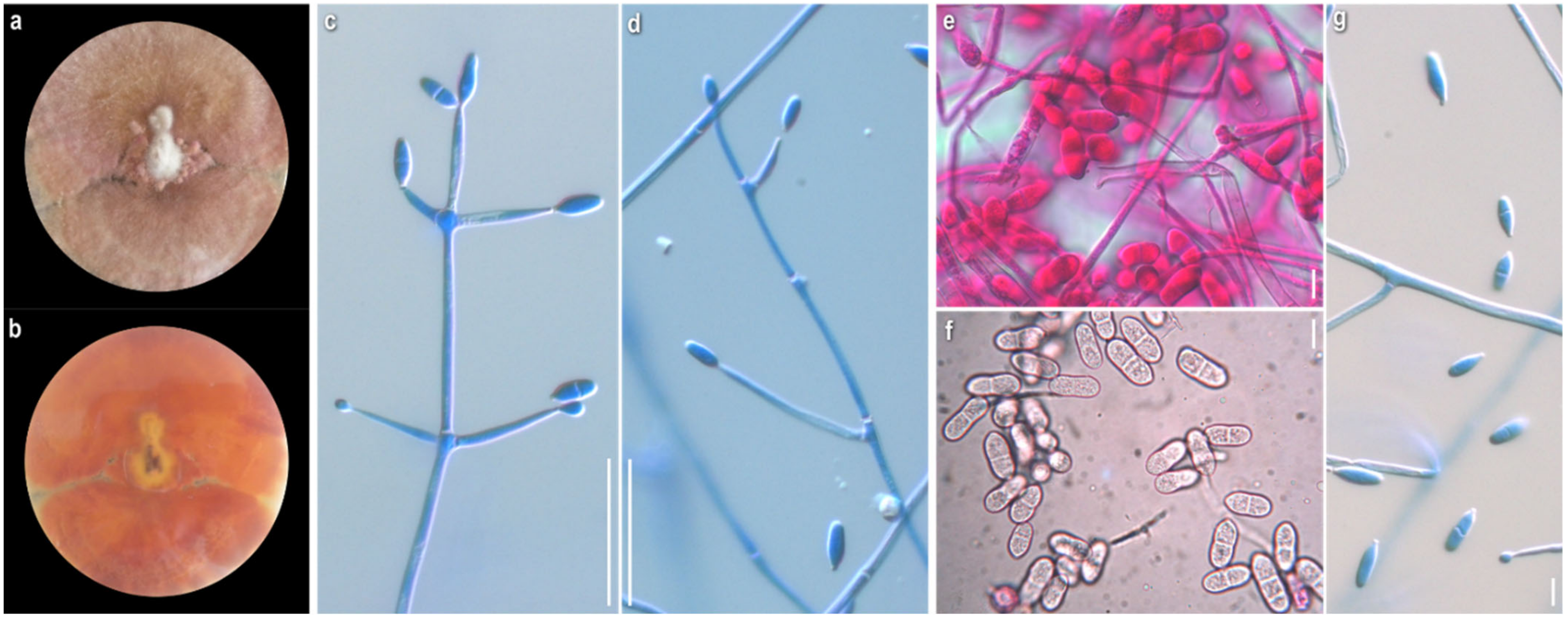
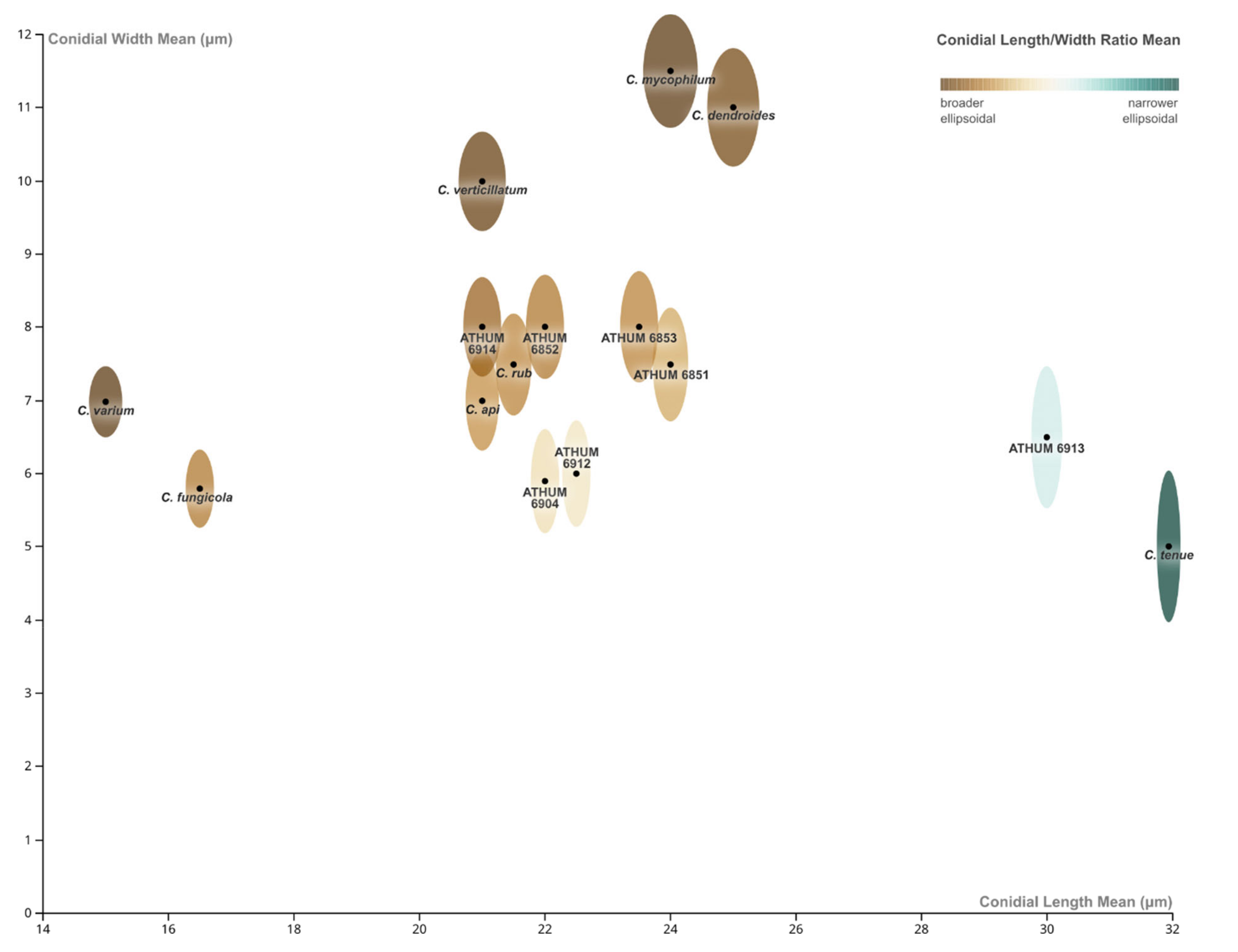
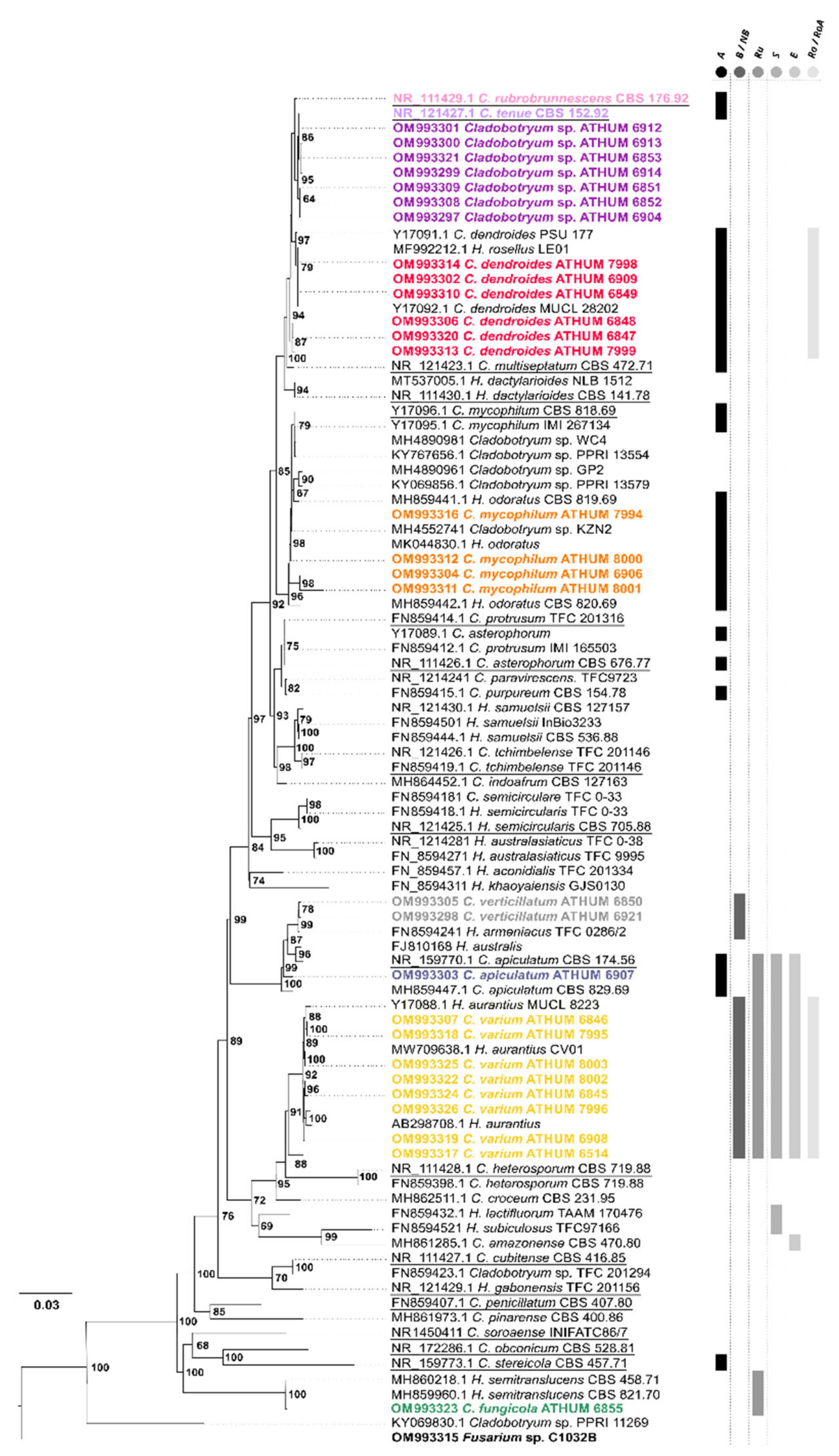


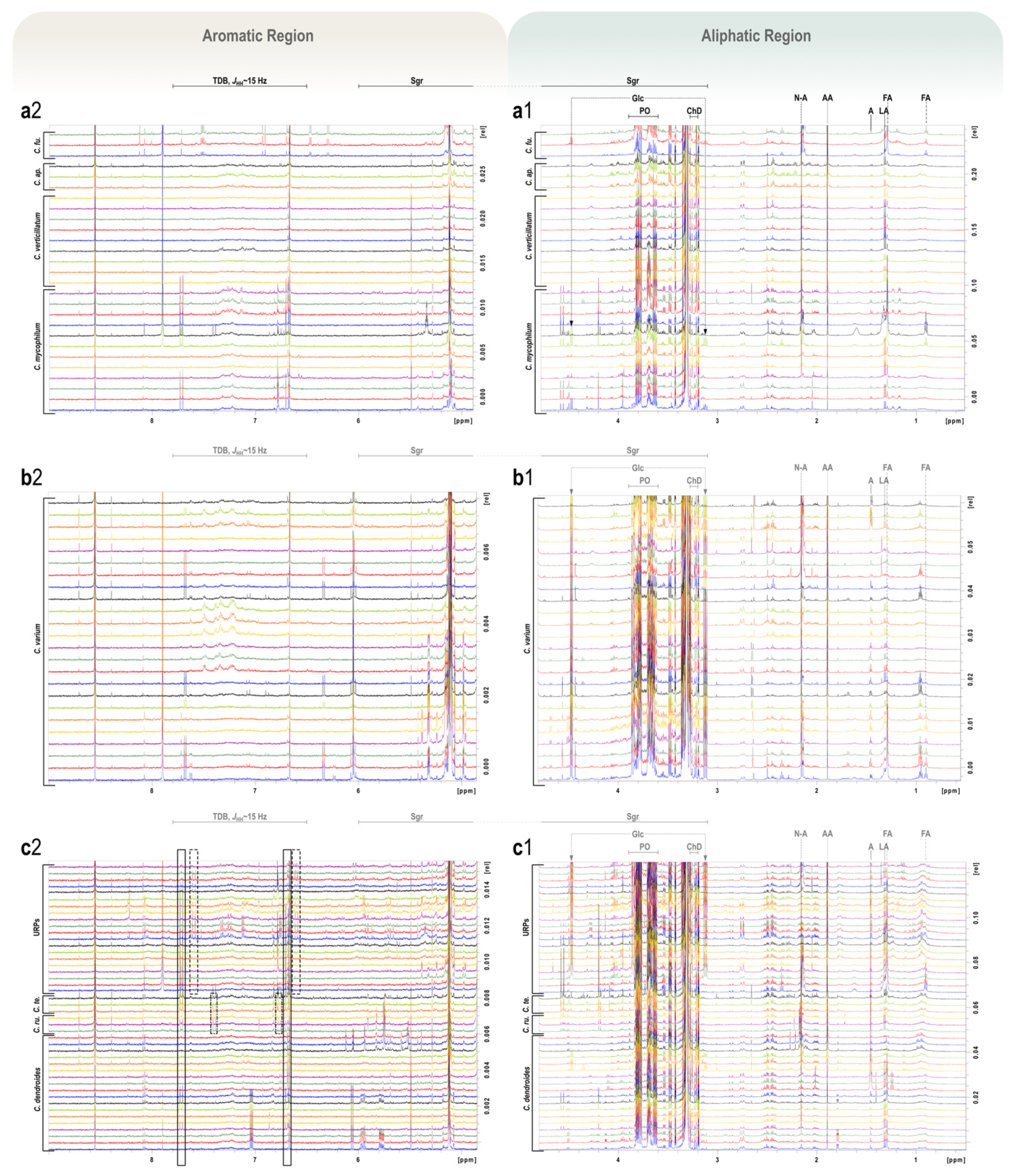
| # | ATHUM Acc. Nos. | Cladobotryum Species | Fungal Host 1 | Habitat, Geographic Origin |
|---|---|---|---|---|
| 1 | 6907 | C. apiculatum | Russula sp. (RUS, Rus) | Fagus sylvatica forest; Mt. Zigourolivado, Ag. Nikolaos, Karditsa |
| 2 | 6847 | C. dendroides | Flammulina sp. (AGA, Phy) | National Gardens, Athens, Attiki |
| 3 | 6848 | C. dendroides | Polyporus varius (POL, Pol) | Fagus sylvatica forest with Juniperus communis; Mt. Leivaditis, Xanthi |
| 4 | 6849 | C. dendroides | Tricholoma sp. (AGA, Tri) | Abies cephalonica forest; Mt. Parnitha, Attiki |
| 5 | 6909 | C. dendroides | polypore basidiome (POL) | Fagus sylvatica forest; Mt. Zigourolivado, Ag. Nikolaos, Karditsa |
| 6 | 7998 | C. dendroides | Hohenbuehelia sp. (AGA, Ple) | Abies cephalonica forest; Mt. Parnitha, Attiki |
| 7 | 7999 | C. dendroides | Helvella lacunosa (ASC) | Platanus orientalis forest with Quercus sp., Abies cephalonica and Castanea sativa (sporadically); Ag. Nikolaos, Eurytania |
| 8 | 6855 | C. fungicola | Cortinarius sp. (AGA, Cor) | Quercus frainetto, Q. pubescens and Q. coccifera forest with Abies cephalonica (sporadically); Mt. Oiti, Mesochori, Fthiotida |
| 9 | 6906 | C. mycophilum | Hypholoma sp. (AGA, Str) | Castanea sp. forest; Mt. Pilio, Magnisia |
| 10 | 7994 | C. mycophilum | Inocybe sp. (AGA, Ino) | Abies borisii-regis forest; Belοkomitis, Karditsa |
| 11 | 8000 | C. mycophilum | Mycena sp. (AGA, Myc) | Platanus orientalis forest with Quercus sp., Abies cephalonica and Castanea sativa (sporadically); Ag. Nikolaos, Eurytania |
| 12 | 8001 | C. mycophilum | Agaricus bisporus (cultivated) (AGA, Aga) | mushroom cultivation unit |
| 13 | CBS 176.92 ex-type | C. rubrobrunnescens | Inocybe sp. (AGA, Ino) | Regensburg, Germany |
| 14 | CBS 152.92 ex-type | C. tenue | agaric basidiome (AGA) | Keilberg at Regensburg, Germany |
| 15 | 6514 | C. varium | Inocybe sp. (AGA, Ino) | Abies borisii-regis forest; near Krikello, Eurytania |
| 16 | 6845 | C. varium | Clitocybula familia (AGA, Mar) | Abies cephalonica forest; Mt. Parnitha, Attiki |
| 17 | 6846 | C. varium | Panellus sp. (AGA, Myc) | Abies cephalonica forest; Mt. Parnitha, Attiki |
| 18 | 6908 | C. varium | agaric basidiome (AGA) | Fagus sylvatica forest; Mt. Zigourolivado, Ag. Nikolaos, Karditsa |
| 19 | 7995 | C. varium | polypore hymenophore (POL) | no data |
| 20 | 7996 | C. varium | polypore basidiome (POL) | Picea abies, Pinus sylvestris and Betula sp. Mt. Frakto, Rodopi |
| 21 | 8002 | C. varium | Ganoderma sp. (POL, Pol) | Abies borisii-regis forest with Juniperus oxycedrus (sporadically); Mt. Tymfristos, Eurytania |
| 22 | 8003 | C. varium | polypore basidiome (POL) | Abies borisii-regis forest; near Krikello, Eurytania |
| 23 | 6850 | C. verticillatum | Lactarius subumbonatus (RUS, Rus) | Quercus sp. forest; Mt. Lykaio, Megalopoli, Arkadia |
| 24 | 6920 | C. verticillatum | Lactarius subumbonatus (RUS, Rus) | Quercus sp. forest; Mt. Lykaio, Megalopoli, Arkadia |
| 25 | 6921 | C. verticillatum | Lactarius subumbonatus (RUS, Rus) | Quercus sp. forest; Mt. Lykaio, Megalopoli, Arkadia |
| 26 | 6851 | Cladobotryum sp. | Laccaria laccata (AGA, Hyd) | Quercus frainetto, Q. pubescens and Q. coccifera forest with Abies cephalonica (sporadically); Mt. Oiti, Mesochori, Fthiotida |
| 27 | 6852 | Cladobotryum sp. | Lactarius salmonicolor (RUS, Rus) | Quercus frainetto, Q. pubescens and Q. coccifera forest with Abies cephalonica (sporadically); Mt. Oiti, Mesochori, Fthiotida |
| 28 | 6853 | Cladobotryum sp. | Russula sp. (RUS, Rus) | Quercus frainetto, Q. pubescens and Q. coccifera forest with Abies cephalonica (sporadically); Mt. Oiti, Mesochori, Fthiotida |
| 29 | 6904 | Cladobotryum sp. | Lactarius sp. (RUS, Rus) | Fagus sylvatica forest; Mt. Zigourolivado, Ag. Nikolaos, Karditsa |
| 30 | 6912 | Cladobotryum sp. | Tricholoma atrosquamosum (AGA, Tri) | Abies cephalonica forest; Mt. Parnitha, Attiki |
| 31 | 6913 | Cladobotryum sp. | Lactarius salmonicolor (RUS, Rus) | Abies cephalonica forest; Mt. Parnitha, Attiki |
| 32 | 6914 | Cladobotryum sp. | Cortinarius sp. (AGA, Cor) | Abies cephalonica forest; Mt. Parnitha, Attiki |
| # | Species | Isolate or Specimen Number | ITS GenBank Acc. Nos. | Country of Origin |
|---|---|---|---|---|
| 1 | C. amazonense | CBS 47080 | MH861285.1 | South Africa |
| 2 | C. apiculatum | CBS 829.69 | MH859447.1 | South Africa |
| 3 | C. apiculatum | CBS 174.56 | NR_159770.1 | Japan |
| 4 | C. apiculatum | ATHUM6907 | OM993303 | Greece |
| 5 | C. asterophorum | TFC 97-23 | Y17089.1 | Australia |
| 6 | C. asterophorum | CBS 676.77 | NR_111426.1 | Japan |
| 7 | C. croceum | CBS 23195 | MH862511.1 | South Africa |
| 8 | C. cubitense | CBS 416.85 | NR_111427.1 | Cuba |
| 9 | C. dendroides | ATHUM6909 | OM993302 | Greece |
| 10 | C. dendroides | ATHUM6848 | OM993306 | Greece |
| 11 | C. dendroides | ATHUM6849 | OM993310 | Greece |
| 12 | C. dendroides | ATHUM7999 | OM993313 | Greece |
| 13 | C. dendroides | ATHUM7998 | OM993314 | Greece |
| 14 | C. dendroides | ATHUM6847 | OM993320 | Greece |
| 15 | C. dendroides | PSU 177 | Y17091.1 | United States |
| 16 | C. dendroides | MUCL 28202 | Y17092.1 | Luxembourg |
| 17 | C. fungicola | ATHUM6855 | OM993323 | Greece |
| 18 | C. heterosporum | CBS 71988 | FN859398.1 | Cuba |
| 19 | C. heterosporum | CBS 719.88 | NR_111428.1 | Cuba |
| 20 | C. indoafrum | CBS 127163 | MH864452.1 | South Africa |
| 21 | C. multiseptatum | CBS 472.71 | NR_121423.1 | New Zealand |
| 22 | C. mycophilum | ATHUM6906 | OM993304 | Greece |
| 23 | C. mycophilum | ATHUM8001 | OM993311 | Greece |
| 24 | C. mycophilum | ATHUM8000 | OM993312 | Greece |
| 25 | C. mycophilum | ATHUM7994 | OM993316 | Greece |
| 26 | C. mycophilum | IMI 267134 | Y17095.1 | United Kingdom |
| 27 | C. mycophilum | CBS 818.69 | Y17096.1 | The Netherlands |
| 28 | C. obconicum | CBS 52881 | MH861373.1 | South Africa |
| 29 | C. obconicum | CBS 528.81 | NR_172286.1 | Belgium |
| 30 | C. paravirescens | TFC 97-23 | NR_121424.1 | Thailand |
| 31 | C. penicillatum | CBS 40780 | FN859407.1 | The Netherlands |
| 32 | C. pinarense | CBS 40086 | MH861973.1 | South Africa |
| 33 | C. protrusum | IMI 165503 | FN859412.1 | Zimbabwe |
| 34 | C. protrusum | TFC 201316 | FN859414.1 | Madagascar |
| 35 | C. purpureum | CBS 154.78 | FN859415.1 | USA |
| 36 | C. rubrobrunnescens | CBS 176.92 | FN859416.1 | Germany |
| 37 | C. rubrobrunnescens | CBS 176.92 | NR_111429.1 | Germany |
| 38 | C. semicirculare | TFC 03-3 | FN859418.1 | Sri Lanka |
| 39 | C. soroaense | INIFATC86/7 | HE792978.1 | Cuba |
| 40 | C. soroaense | INIFATC86/7 | NR_145041.1 | Cuba |
| 41 | Cladobotryum sp. | TFC 201294 | FN859423.1 | Madagascar |
| 42 | Cladobotryum sp. | PPRI 11269 | KY069830.1 | N/A |
| 43 | Cladobotryum sp. | PPRI 13579 | KY069856.1 | N/A |
| 44 | Cladobotryum sp. | PPRI 13554 | KY767656.1 | N/A |
| 45 | Cladobotryum sp. | KZN-2 | MH455274.1 | South Africa |
| 46 | Cladobotryum sp. | GP-2 | MH489096.1 | South Africa |
| 47 | Cladobotryum sp. | WC-4 | MH489098.1 | South Africa |
| 48 | Cladobotryumsp. | ATHUM6904 | OM993297 | Greece |
| 49 | Cladobotryumsp. | ATHUM6914 | OM993299 | Greece |
| 50 | Cladobotryumsp. | ATHUM6913 | OM993300 | Greece |
| 51 | Cladobotryumsp. | ATHUM6912 | OM993301 | Greece |
| 52 | Cladobotryumsp. | ATHUM6852 | OM993308 | Greece |
| 53 | Cladobotryumsp. | ATHUM6851 | OM993309 | Greece |
| 54 | Cladobotryumsp. | ATHUM6853 | OM993321 | Greece |
| 55 | C. stereicola | CBS 457.71 | NR_159773.1 | Russia |
| 56 | C. tchimbelense | TFC 201146 | NR_121426.1 | Gabon |
| 57 | C. tchimbelense | TFC 201146 | FN859419.1 | Gabon |
| 58 | C. tenue | CBS 152.92 | NR_121427.1 | Germany |
| 59 | C. varium | ATHUM6846 | OM993307 | Greece |
| 60 | C. varium | ATHUM6514 | OM993317 | Greece |
| 61 | C. varium | ATHUM7995 | OM993318 | Greece |
| 62 | C. varium | ATHUM6908 | OM993319 | Greece |
| 63 | C. varium | ATHUM8002 | OM993322 | Greece |
| 64 | C. varium | ATHUM6845 | OM993324 | Greece |
| 65 | C. varium | ATHUM8003 | OM993325 | Greece |
| 66 | C. varium | ATHUM7996 | OM993326 | Greece |
| 67 | C. verticillatum | ATHUM6921 | OM993298 | Greece |
| 68 | C. verticillatum | ATHUM6850 | OM993305 | Greece |
| 69 | H. australis | FJ810168 | China | |
| 70 | H. aconidialis | TFC 201334 | FN859457.1 | Madagascar |
| 71 | H. armeniacus | TFC 02-86/2 | FN859424.1 | France |
| 72 | H. aurantius | AB298708.1 | Japan | |
| 73 | H. aurantius | CV01 | MW709638.1 | China |
| 74 | H. aurantius | MUCL 8223 | Y17088.1 | Canada |
| 75 | H. australasiaticus | TFC 03-8 | NR_121428.1 | Sri Lanka |
| 76 | H. australasiaticus | TFC 99-95 | FN859427.1 | Australia |
| 77 | H. dactylarioides | NLB 1512 | MT537005.1 | Australia |
| 78 | H. dactylarioides | CBS 141.78 | NR_111430.1 | New Zealand |
| 79 | H. gabonensis | TFC 201156 | NR_121429.1 | Gabon |
| 80 | H. khaoyaiensis | GJS01-304 | FN859431.1 | Thailand |
| 81 | H. lactifluorum | TAAM170476 | FN859432.1 | USA |
| 82 | H. odoratus | CBS 819.69 | MH859441.1 | The Netherlands |
| 83 | H. odoratus | CBS 820.69 | MH859442.1 | The Netherlands |
| 84 | H. odoratus | MK044830.1 | China | |
| 85 | H. rosellus | isolate LE01 | MF992212.1 | Spain |
| 86 | H. samuelsii | InBio3-233 | FN859450.1 | Costa Rica |
| 87 | H. samuelsii | CBS 536.88 | FN859444.1 | Cuba |
| 88 | H. samuelsii | CBS 127157 | NR_121430.1 | Puerto Rico |
| 89 | H. semicircularis | CBS 705.88 | NR_121425.1 | Cuba |
| 90 | H. semitranslucens | CBS 821.70 | MH859960.1 | Sweden |
| 91 | H. semitranslucens | CBS 458.71 | MH860218.1 | Russia |
| 92 | H. subiculosus | TFC 97-166 | FN859452.1 | Puerto Rico |
| 93 | Fusarium sp. | C1032B | OM993315 | Greece |
Publisher’s Note: MDPI stays neutral with regard to jurisdictional claims in published maps and institutional affiliations. |
© 2022 by the authors. Licensee MDPI, Basel, Switzerland. This article is an open access article distributed under the terms and conditions of the Creative Commons Attribution (CC BY) license (https://creativecommons.org/licenses/by/4.0/).
Share and Cite
Milic, N.; Christinaki, A.C.; Benaki, D.; Stavrou, A.A.; Tsafantakis, N.; Fokialakis, N.; Kouvelis, V.N.; Gonou-Zagou, Z. Polyphasic Systematics of the Fungicolous Genus Cladobotryum Based on Morphological, Molecular and Metabolomics Data. J. Fungi 2022, 8, 877. https://doi.org/10.3390/jof8080877
Milic N, Christinaki AC, Benaki D, Stavrou AA, Tsafantakis N, Fokialakis N, Kouvelis VN, Gonou-Zagou Z. Polyphasic Systematics of the Fungicolous Genus Cladobotryum Based on Morphological, Molecular and Metabolomics Data. Journal of Fungi. 2022; 8(8):877. https://doi.org/10.3390/jof8080877
Chicago/Turabian StyleMilic, Nikola, Anastasia C. Christinaki, Dimitra Benaki, Aimilia A. Stavrou, Nikolaos Tsafantakis, Nikolas Fokialakis, Vassili N. Kouvelis, and Zacharoula Gonou-Zagou. 2022. "Polyphasic Systematics of the Fungicolous Genus Cladobotryum Based on Morphological, Molecular and Metabolomics Data" Journal of Fungi 8, no. 8: 877. https://doi.org/10.3390/jof8080877
APA StyleMilic, N., Christinaki, A. C., Benaki, D., Stavrou, A. A., Tsafantakis, N., Fokialakis, N., Kouvelis, V. N., & Gonou-Zagou, Z. (2022). Polyphasic Systematics of the Fungicolous Genus Cladobotryum Based on Morphological, Molecular and Metabolomics Data. Journal of Fungi, 8(8), 877. https://doi.org/10.3390/jof8080877






